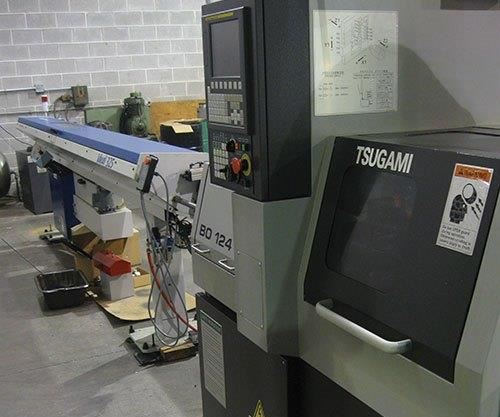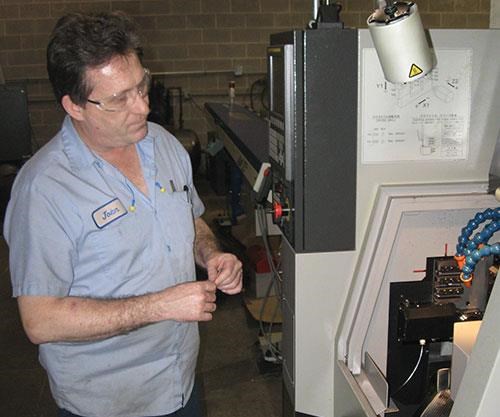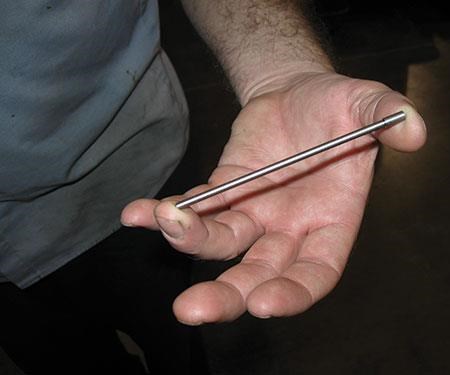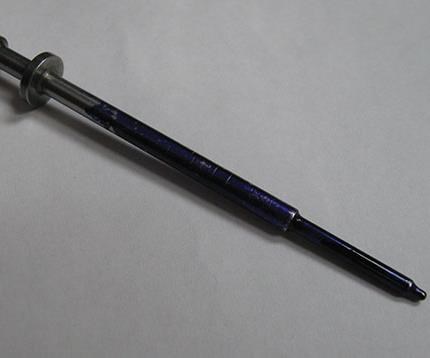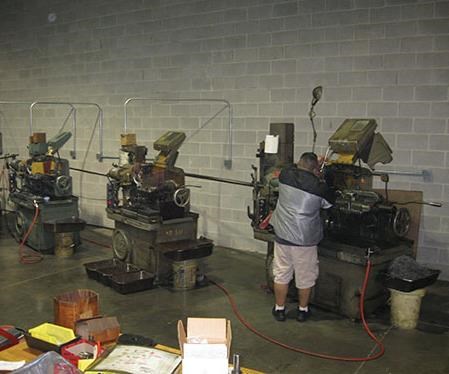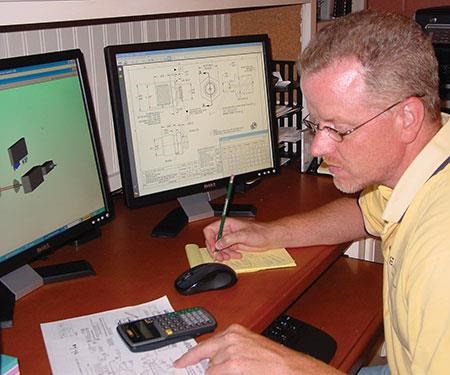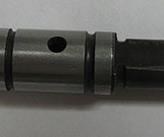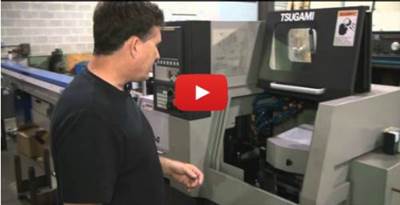Understanding Swiss-Type Machining
Once seen as a specialty machine tool, the CNC Swiss-type is increasingly being used in shops that are full of more conventional CNC machines. For the newcomer to Swiss-type machining, here is what the learning curve is like.
Share





Who is using CNC Swiss-type lathes? The answer has been changing. While medical and electronics applications accounted for large shares of investment in this type of machine tool in past years, more recent adopters have been more evenly spread across various industry applications. As shops come to discover the value of CNC Swiss-types, many are installing this type of machine for the first time.
Groth Manufacturing is an example. The contract manufacturer in Carpentersville, Illinois, has 35 CNC machine tools, including horizontal and vertical machining centers as well as CNC lathes. Its most recent machine purchase is a B0124 CNC Swiss-type from Tsugami.
The application in this case is defense-related. Swiss-type machining provides a cost-effective way to produce dust cover pins and firing pins used in military rifles. These long, slender components feature a tolerance band of 0.0005 inch on the part’s diameter.
Company President John Groth says the components used to be machined on a more conventional CNC turning center. A box tool turned the precise diameter. However, when the customer asked to be able to order parts in smaller quantities and with shorter lead times, the shop had to begin carrying inventory to accommodate the request. Stocking the inventory created extra expense, so Mr. Groth had to find an offsetting cost reduction. The efficiency gain from turning the pins more quickly on a CNC Swiss-type delivered the needed savings.
A Swiss-type lathe is a variety of turning machine that feeds the stock through a guide bushing. This means the OD turning tool can always cut the stock near the bushing, and therefore near the point of support, no matter how long the workpiece. The machine feeds the work out of the spindle and past the tool as it goes. This makes the CNC Swiss-type particularly effective for long and slender turned parts.
In a way, Mr. Groth’s purchase of a CNC Swiss-type meant coming full circle. His company had been a screw machine shop. When he bought it from its previous owner, the machine tools that came with it were cam-driven automatic lathes for precise production of small turned parts. Mr. Groth, a toolmaker, had no previous experience with this type of machine, so he taught himself to use them. He learned with his own time and his own hands how to set up these machines and apply them effectively, even efficiently. Building on the revenue these machines brought in, he gradually expanded the shop (from 7,000 square feet then to 22,000 square feet now) and added one CNC machine after another. Now, the latest of those machines is the Swiss-type.
Relative to other CNC machines, he says the biggest adjustment with this machine has probably been the programming. The machine moves in ways that are foreign compared to other CNC lathes. Some M codes and waiting commands are also different. For the sake of learning the machine and developing proficiency with it, Mr. Groth is forgoing CAM software for now in order to program the machine by hand at the control.
“I want to know what I can do on this machine, and what I can get away with,” he says. Finding and proving out time-saving moves will enable him to use the machine more productively in the future. At least, that was his experience when he was getting to know those cam-driven machines back when his shop was new. Once again on the Swiss-type, Mr. Groth is teaching himself to use the machine effectively.
Different Thinking
Douglas Paoletta knows something about that learning curve. A programmer of CNC Swiss-types who recognized the increasing popularity of these machines, he founded a business aimed at helping machining facilities become proficient with them. Encompass Swiss Consulting, based in Richmond Heights, Ohio, provides both contract programming and instructional services related to these machines.
Compared to conventional CNC turning, CNC Swiss-type machining is a different experience, he says. Machinists and programmers shifting from one to the other have to adapt their thinking about the machining cycle in various ways. He cites the following differences:
1. Negative becomes positive
On a CNC Swiss-type, the Z-axis motion comes from the stock moving instead of the tool. This change affects the nature of programming offsets.
He says, “On a conventional lathe, the stock sticks out from the chuck by a specified length. The face of the part is Z zero and everything into the part is Z negative.” By contrast, on the Swiss machine, the turning tool is stationary and the stock advances. “Z zero is the face of the part, just as on the conventional lathe, but everything beyond the face is Z positive.”
The difference is vital to remember when it comes to Z-axis offsets. Making a turn length longer or a drilling pass deeper entails a “minus” offset on the conventional lathe, but calls for a “plus” offset on the Swiss-type.
2. Machine in segments
The order of cuts in the cycle also changes with a Swiss-type. On a conventional lathe, it is typical to rough turn and finish turn the work, then machine features such as OD grooves or threads to complete the part. Not so on a Swiss-type.
“Due to the length of the guide bushing, we have to segment the part into sections, or the bar stock would fall out of the guide bushing when we retract the stock,” he says. This segmenting typically means machining the part in sections of 0.750 inch, the length of the standard guide bushing land area. Thus, the machining sequence might go: OD turn up to the location of a groove, machine that groove, bring back the previous tool to resume OD turning, and so on.
3. The guide bushing is critical
The guide bushing is the heart of the Swiss-type machine. Sizing is essential. Using a guide bushing that is the wrong size for the work will result in concentricity errors.
In addition, guide bushings come in various materials—carbide sleeved, Meehanite, steel—because the potential for interaction with the workpiece material is another crucial factor to consider.
4. Oil instead of water
Most Swiss-type machines use oil as the cutting fluid rather than water. The lubricity is greater. Benefits include freedom from odor-causing bacteria growth, as well as from the prune-like hands that result from being exposed to water-based coolant all day. However, the major downside is found in that very word, “coolant.” Compared to water, oil is less effective at dissipating heat. A Swiss machine cutting quickly can therefore become hot inside the work zone, Mr. Paoletta says—to the point that gloves or shop towels might be needed when changing tools. Equipping the machine with a fire-suppression system is prudent.
5. Amazing machining cycles
Mr. Paoletta says he loves to see the shift in thinking that occurs when a new Swiss-type user completes a part in one cycle that previously required multiple operations or even multiple machines. Conventional CNC lathes usually have three or four axes. The Swiss-type is likely to have anywhere from seven to 13 axes. Seeing how much work can be quickly performed within the machine’s small work zone can amaze shop personnel who begin to use this type of machine for the first time.
Double Productivity
Mr. Groth was amazed, and his machine does not even have that high number of axes. He runs the rifle pins on a turning-only Swiss-type machine. Yet he had become accustomed to machining the parts gingerly when he ran them on the more conventional lathe. If he cut too aggressively, the slender parts would deflect enough to leave tool marks on the machined surface. By comparison, the much greater stability the Swiss-type brings to cutting means that he doesn’t have to be delicate anymore. Productivity of the rifle pins has more than doubled as a result.
But at the same time, batch sizes are not large. Although his screw machines are not directly comparable to the Swiss-type, they are also productive for precision machining of small turned parts. Indeed, he still quotes new jobs for them. However, these machines are not effective for the small production quantities his customers increasingly require, because their setup times are too long. Thus, the CNC Swiss-type machine is perhaps uniquely suited for small and delicate parts with both tight tolerances and small production quantities.
His shop will get another CNC Swiss-type, he says, because he sees considerable opportunity in parts that fit this very description. However, the next Swiss-type he buys will be different. The current one was chosen for a particular family of parts; it accommodates a maximum bar size of 12 mm. Barstock up to 20 mm is the size he would choose next. In addition, he says his next CNC Swiss-type will feature live tooling, in order to fully realize the range of parts that a machine such as this can produce.
Related Content
The Future of High Feed Milling in Modern Manufacturing
Achieve higher metal removal rates and enhanced predictability with ISCAR’s advanced high-feed milling tools — optimized for today’s competitive global market.
Read MoreOrthopedic Event Discusses Manufacturing Strategies
At the seminar, representatives from multiple companies discussed strategies for making orthopedic devices accurately and efficiently.
Read MoreLean Approach to Automated Machine Tending Delivers Quicker Paths to Success
Almost any shop can automate at least some of its production, even in low-volume, high-mix applications. The key to getting started is finding the simplest solutions that fit your requirements. It helps to work with an automation partner that understands your needs.
Read MoreBallbar Testing Benefits Low-Volume Manufacturing
Thanks to ballbar testing with a Renishaw QC20-W, the Autodesk Technology Centers now have more confidence in their machine tools.
Read MoreRead Next
Video: Swiss-Type Machining Explained
This Chicago-area contract manufacturer has found success explaining his shop’s capabilities to purchasing professionals by creating a YouTube page. This video explains the shop’s latest capability: CNC Swiss-type machining.
Read MoreSetting Up the Building Blocks for a Digital Factory
Woodward Inc. spent over a year developing an API to connect machines to its digital factory. Caron Engineering’s MiConnect has cut most of this process while also granting the shop greater access to machine information.
Read More5 Rules of Thumb for Buying CNC Machine Tools
Use these tips to carefully plan your machine tool purchases and to avoid regretting your decision later.
Read More

